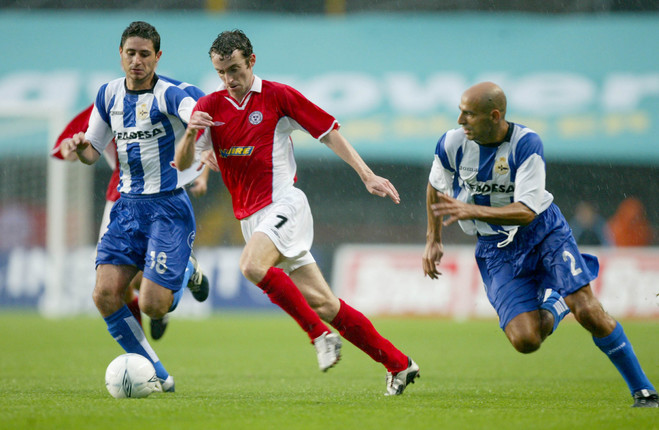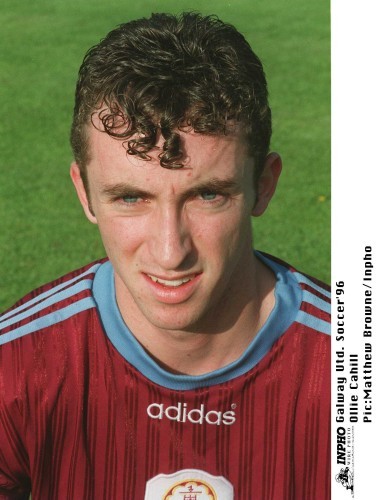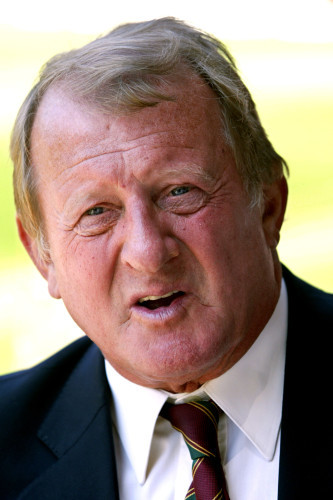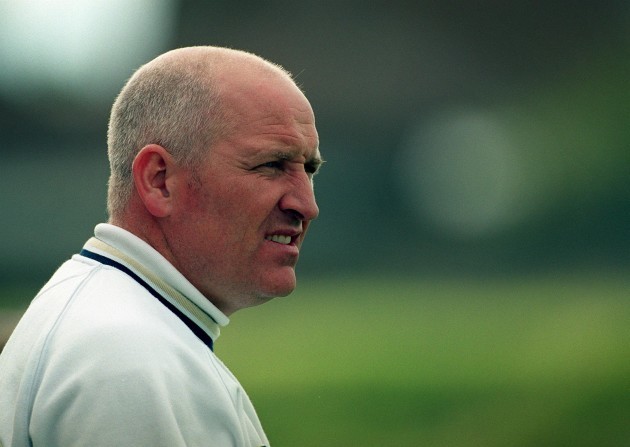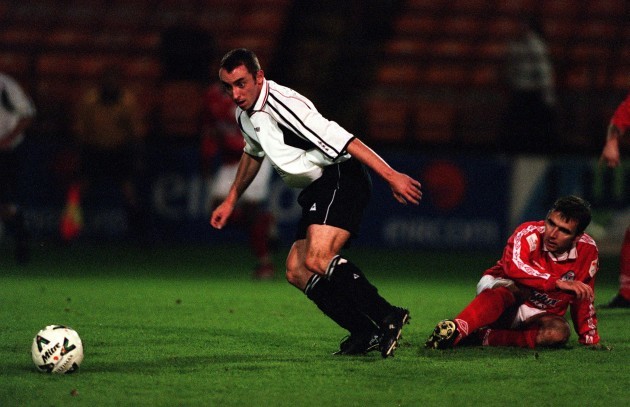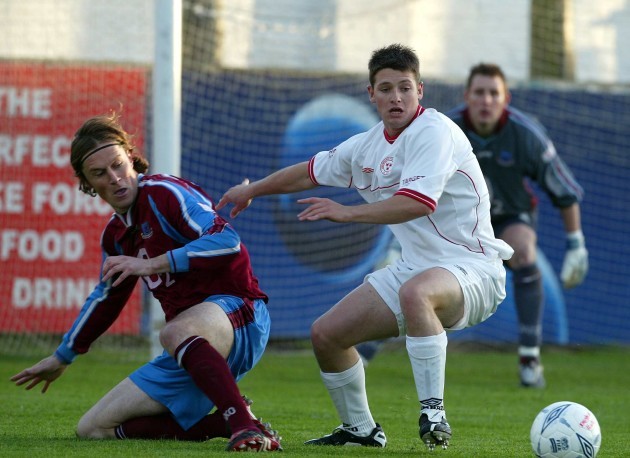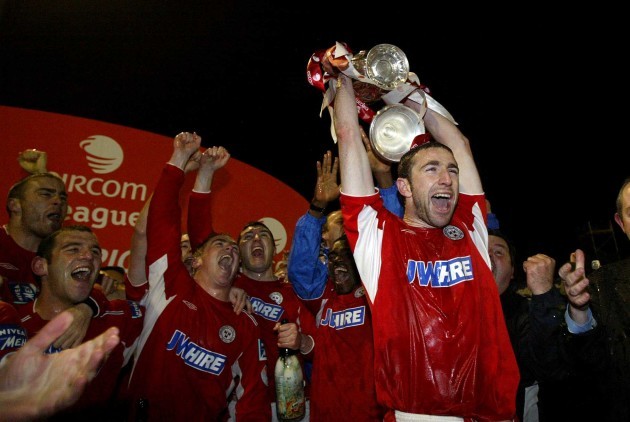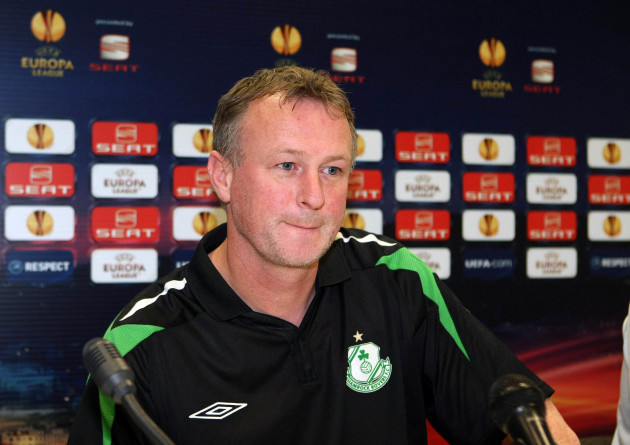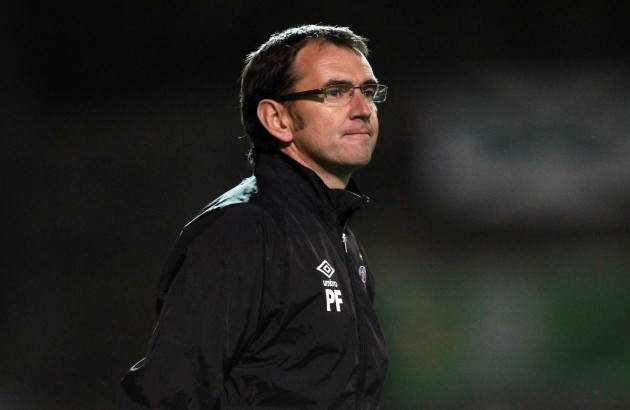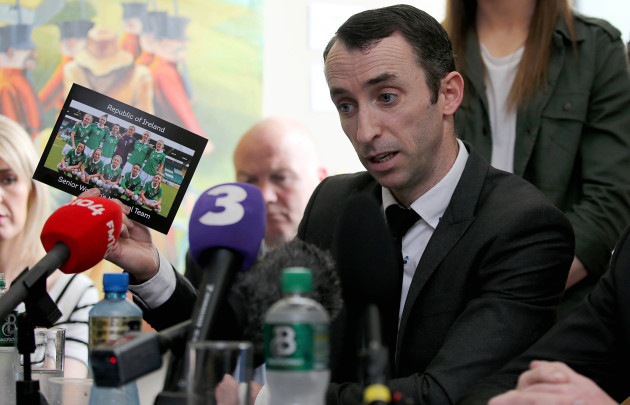THERE ARE COUNTLESS stories in football of wasted talent. Truly gifted players who, for one reason or another, never fully did justice to their ability.
And on the other hand, there are the admirable types such as Ollie Cahill — footballers who will never seldom come close to emulating the likes of a Lionel Messi or Cristiano Ronaldo, but regardless manage to carve out a very successful career in the game at a certain level anyway.
Over the course of a 17-year career in football, Cahill’s achievements speak for themselves. And unlike a number of fast and skillful wingers from down through the years, the accomplished Clonmel native — who has made at least one list of the top 10 League of Ireland footballers of the 2000s — had a longevity in football befitting of his faultless work ethic, playing at Premier Division level well into his 30s.
Not many players can claim to have won five league winners’ medals, including four in the space of five years with two different clubs (Shelbourne and Drogheda).
Moreover, Cahill has won every domestic honour in the League of Ireland at least once, while according to the official website of the Professional Footballers’ Association of Ireland (PFAI), he holds the record for the most European appearances by an Irish-based player (41).
A list of the company he has kept on a football pitch is also telling — he lists Wes Hoolahan, Joseph N’Do, Patsy Freyne, Owen Heary, Pat Morley and Jason Byrne as being among the best players he has played with, while he comes up with Liam Coyle as the best opponent he witnessed in action. Of the Derry City legend, he adds: “I didn’t see him in his heyday, but even with the dodgy knee and the injury, he was an incredible player to come up against.”
1. The GAA career that might have been
It could have been so different though. Cahill grew up a sports fanatic and might well have been good enough to become a GAA star had it not been for the lure of professional soccer. A keen hurler and Gaelic footballer, he represented Tipperary at minor level in the latter, while he was a dual player for the local schools team.
A fine athlete, Cahill managed to balance his GAA playing with soccer for local side OldBridge FC, helping them to win a Munster Junior Cup.
Clonmel is a big enough sporting town and I was always into sport,” he tells The42. “I played them all, I played as many as I could.”
And if a career in soccer had somehow not worked out, does he feel he would have been good enough to play GAA at a high level?
Having played for the minor football team, that probably would have been the route I would have gone down,” he says. “I enjoyed playing both, but I was probably a better Gaelic footballer than a hurler.
“Potentially, I could have gone on to play senior football with Tipperary — I’d won a few titles with my club Clonmel Commercials at underage and minor level.”
Soccer, however, was always his first love, though he feels he had to do that bit extra to get noticed, given that he was performing away from Ireland’s footballing hotbeds such as Dublin and Cork.
“I didn’t have any underage caps for Ireland,” he recalls. “I was never really on the radar back then. I’d always wanted to play football and thought I was good enough to get an opportunity to play, but the opportunity never arose. We play against good Dublin and Cork teams and got to a national U15 semi-final with OldBridge at one stage.
You’re playing against other teams along the way (who had) underage internationals. You’d play against them and think: ‘I’m every bit as good as them.’ That opportunity never came until I started playing with Clonmel Town on that national stage — winning the FAI Junior Cup propelled me into the spotlight.
“Young lads playing in Dublin or Cork were getting underage caps and going to England on trials for a club — as a 13 or 14-year-old, I never had that. I always thought I was good enough, you just think that the opportunity won’t come. I kept my head down and played, and the opportunity did come eventually.
It’s different now with social media — everyone is aware of everyone. Back then, I was just playing football at home in Tipperary. The feeling back then was if you were playing in Dublin or Cork, you might have had (more of) an opportunity to get spotted.
“I know they now have the Emerging Talent programmes and there are more opportunities to get into underage set-ups and catch the eye of scouts from England, but (back then) I thought, you really have to go that extra yard to try to get something coming from Tipperary.
But I never doubted I was good enough. I always thought (soccer) might lead to something, whether that was England or League of Ireland. ‘I just might get spotted somewhere along the way.’ That was always in your mind and that would have been the thought process.
“I just wanted to play and enjoyed playing, but if the opportunity didn’t come to go to England, I would have stayed home to play Gaelic football, hurling and soccer for Clonmel Town, and enjoyed doing it.”
2. Hero to zero
Having impressed at the age of 18 during that aforementioned FAI Junior Cup run with Clonmel Town, in 1994 he joined Northampton Town, who were then a side playing in Division Three in England (or League Two as it is now known).
In doing so, he left his family and promising GAA career behind in Tipperary.
I went over on trial and once the chance to become a professional footballer was there, there wasn’t any real choice,” he explains.
“To earn a living playing soccer was every kid’s dream and I was no different. There were no thoughts of staying and sticking with GAA, it was soccer all the way. I signed for Northampton and I was delighted to do so.”
Despite coming from a relatively unorthodox background by Irish footballing standards, Cahill managed to adapt reasonably well initially at Northampton, promptly breaking into the first team with former Arsenal and Nottingham Forest player John Barnwell as manager.
It was a massive jump, going from playing local junior football in Tipperary to a professional set-up like Northampton Town,” he says. “There wasn’t any real homesickness — I was put in really good digs with a family that looked after me.
“In the first six months there, I played about 10 or 11 games in total, whether that was starting or coming off the bench. I felt like I was making progress. John Barnwell wanted to play football even though we were down towards the bottom of Division Three.
I was making progress, the manager believed in me and was giving me opportunities. Around Christmas time in my first year there, he got sacked. Ian Atkins came in as manager, he pretty much played long-ball football and wanted physical guys who would run all day. I didn’t really fit into those plans.
“Even though I stayed on for another year, I turned down a contract for a year after that. I felt I wasn’t getting a fair crack at it, I didn’t fit into (Atkins’) style of play. But it was still a great two years and made me the player that I was.”
Cahill’s differing fortunes under two managers at Northampton highlights how perilous life as a footballer can be. Indeed, had he enjoyed better luck, the young winger may well have gone on to have had a successful long-term career in England.
“It’s a game of opinions,” he adds. “Everyone has their opinions and if a manager likes you, that can go a long way.
In my first six months (with Northampton), David Pleat was manager of Luton Town at the time. We played them in a couple of friendlies. I caught his eye and they put in a bid for me, but it was just around the time the manager had been sacked.
“The new manager came in and said ‘no one’s going anywhere’. Pleat moved on to Spurs after that and I spent the next few months probably playing two or three games in total. There are a lot of stories like that.
Things could go the other way. You might not be playing under a manager — he gets sacked or leaves, another guy comes in and fancies you. You can move on from here, but I went the other way. So if John Barnwell had stayed and I continued to play, who knows what it might have led to.”
3. Redemption at Cork
After turning down the contract extension at Northampton, Cahill returned home to Ireland in the summer of 1994. A newspaper article was consequently published, detailing the youngster’s misfortune across the water and subsequent availability.
Before long, a number of Irish clubs were seemingly vying for the winger’s services. Cahill trained with Galway and Dundalk, while playing a few minutes of a friendly for Waterford, but it was ultimately Cork City that he opted to sign for.
The Leesiders were managed by Dave Barry at the time, and though Cahill spent six years at Turner’s Cross, he was initially not overly impressed with certain aspects of life at his new club, in comparison to what he had been used to over in England.
It was hard to compare, but in terms of general professionalism and set-up, I thought the League of Ireland was a good bit behind. Northampton had decent training facilities. They’d just moved into a brand new stadium. Football in England is an industry.
“After going back to Cork, you could be training in local parks. At Northampton, you’d have the training gear all laid out for you whereas it wouldn’t have been at Cork.
The two years in England would have hardened me up and I was able for the physical side of play in League of Ireland football. But it was still a decent standard, we had some really good players and Dave Barry built a pretty good squad.
“In my six years there, we were competitive, and probably should have won the league at some stage. It was disappointing not to. From playing in England, in my time you’d think League of Ireland is a massive step down, but it wasn’t really. It was different in some ways, but the standard was really good. I got into it really quickly and loved my time in Cork.”
Following the frustrating end to his Northampton career, Cahill credits the Leesiders for not only giving him an opportunity at his lowest footballing ebb, but also in helping him rediscover his passion for the sport.
The last year (at Northampton) wasn’t great. You train to play and I wasn’t playing first-team games, so I wasn’t getting on with the manager.
“I turned down a new contract and basically, for the last few months, the manager wouldn’t really talk to me and things went sour.
I came back home in the summer and re-assessed things. I just got back to enjoying playing football and enjoying being back home.
“We had a good side at Cork. It started slow enough, but we gradually got better.”
With Cahill constantly tormenting opposition defenders, Barry’s side frequently excelled on the field, even if they could not quite manage to claim that elusive League of Ireland title.
They won a League of Ireland Cup in the 1998-99 season, beating Shamrock Rovers 2-1 in the final, but the highlight of Cahill’s time at Turner’s Cross undoubtedly came the season before, when they won Cork City’s first-ever FAI Cup, a trophy the Rebels have only claimed twice since (in 2007 and 2016).
Having drawn the first game 0-0, they overcame Shelbourne by a single goal after a replay at Dalymount Park, as Derek Coughlan headed home a Kelvin Flanagan corner 15 minutes from time.
There was much relief as well as elation, given that Cork had experienced a number of near misses in the competition prior to that unforgettable moment of glory.
Winning the FAI Cup was massive,” Cahill remembers. “We could have won the first game in Dalymount. We had a few opportunities. The pitch was hard to play on, it wasn’t a great game to watch.
“Winning it in Cork, a one-club city, with everyone behind us (was special). Getting the train down and an open-top bus through the city, it gave us great memories. It’s one of the highlights of any player’s career to be winning an FAI Cup.
He continues: “I was never too bad with the nerves (before a crucial match). The bigger the game the better. I really used to enjoy the big games. You have a bit of anxiousness just to get on the pitch and get on with it, but I wasn’t really one for suffering from nerves. Some guys do. Some guys would be in the toilet getting sick or whatever, but I’d just look forward to it.”
4. Realising potential
Despite this degree of success, Cahill was not entirely content at Cork. In his six years there, the club had been runners-up on two occasions and finished third twice, but they just couldn’t do enough to claim that silverware they sought so desperately. To make matters worse, in the winger’s final season with the Leesiders, they finished sixth and were seemingly further away than ever from a league triumph.
Shelbourne, by contrast, were the best side in the country at the time, and had just claimed a second league title in the space of three years. When the Dublin side’s interest became apparent, after six good years at Cork, Cahill felt the chance to join the reigning champions was an opportunity too good to turn down.
“Cork gave me my break and my League of Ireland career blossomed from there. But I felt at the time that the club weren’t really ambitious enough to go and win a league title. I’d won an FAI Cup and a League Cup. I was 26 when I left — I was at the point in my career where I really wanted to start winning league titles. The best team always wins the league, and that’s where you want to be at.
“It felt like Cork could never go and sign players from Dublin clubs. They were reliant on local talent and there’s nothing wrong with that — Cork guys who maybe were coming back from England. I felt if they really went after some of the better players in the League of Ireland, tried to attract them to Cork, they could build something and really push to win things.
“Shelbourne were interested, I met them, spoke to them and signed for them in 2002. It was an easy decision in one sense — they were an ambitious club and one of the best sides around… But it was difficult to leave Cork after six good years there.”
Cahill certainly succeeded in his aim of securing trophies during his time at Shels, winning League of Ireland titles there in 2003, 2004 and 2006.
To win that first (league title) was very special,” he says. “I got the jersey I was wearing when I won the title signed by the lads, and I gave it to my dad, so it’s still hanging up at home in Tipperary.
“When you win the first one, it gives you a taste and you want more. At a club like Shels, everything is geared towards winning league titles, pushing in Europe and trying to progress the club. The players would push you to win more and you were always striving to achieve more.
That dressing room was full of winners and strong characters. At Shelbourne, there’s an expectation on you to win. Certain players thrive on that, others crumble, they can’t hack it and are gone.
“The likes of Owen Heary, Stuey Byrne, Jason Byrne — when we were training, we trained hard, we trained to win, and that was reflected on the pitch.
“After we won that first title, we pushed each other on. Pat Fenlon was manager, he set the tone and that filtered down to the players.
“To win three league titles was a fantastic achievement and the run we went on in Europe was great. It was probably the best period of my career.
Those Shelbourne days, they were special days, and I hold a special place for Shelbourne — they’re probably my club if I was asked now.”
5. The making of a future Ireland international
One player in particular on that team would go on to bigger and better things. Future Ireland and Norwich star Wes Hoolahan was only a youngster back then, but his immense talent was always obvious for everyone to see.
He was one of those guys who was born to have a football at his feet,” Cahill explains. “He was just gifted. You’d see him in training drifting by players with ease.
“You could put him into a World Cup final and he’d play the same way as he’d play on the street. He had the ability to drop a shoulder. Playing against him in training was a nightmare, because you knew what was coming, but there was nothing you could do about it — he just ran by you, or he’d pick a pass out, or stick it in the net.
At the time, he probably wasn’t a top professional because it came so easy to him and he’s so natural, but he got better and better. He improved as a professional and probably thought, I’ve a chance of doing something here if I get my head on and in fairness to him, he did.
“Seeing what he’s gone on to now, it’s no surprise to anyone who played with him, seeing the talent and ability he had.
There are people out there who say he should have had more Ireland caps and should have been an integral part of that international team for longer than he has been, but fair to play to him, he’s made a good career for himself. His ability and talent deserve that, because if he wasted that, it would have been a shame.
“I’ve seen players who have wasted it, but fortunately, he hasn’t. He’s gone on to achieve great things and is a great guy as well, all credit to him.”
6. European dreams
During his time at Shels, Cahill was part of one of Irish football’s most memorable occasions over the past 20 years, as the Dublin side came up against Deportivo, who were one of the top teams in Europe at the time and had reached the semi-finals of the Champions League only a couple of months previously.
That memorable game had come only two years after what Cahill describes as one of his “worst experiences” in football. After drawing the away leg 2-2, Shelbourne were looking set to progress before a last-minute goal in the home game saw them dumped out of the Champions League in embarrassing fashion by Hibernians of Malta.
At Tolka Park, we were all over them. We had a goal disallowed and just couldn’t score. They scored a 93rd-minute winner and they went on to play Boavista of Portugal in the next round.
“That was one of the lowest points of my career, after only signing for Shels, I’ll never forget that feeling.”
But Pat Fenlon’s side more than made up for this disappointment in 2004. A superb European run saw them defeat both KR of Iceland and Croatian side Hajduk Split, before facing formidable opposition in the form of the team who had been crowned La Liga champions just over four years previously.
That Shelbourne side could make a strong claim to be among the best in the League of Ireland’s history: Steve Williams, Owen Heary, Jamie Harris, Dave Rogers, David Crawley, Stuey Byrne, Joseph N’Do, Wes Hoolahan, Alan Moore, Jason Byrne and of course, Cahill.
There were impressive players in reserve too, with the likes of Jim Crawford, Thomas Morgan, Alan Cawley and Glen Fitzpatrick among the individuals on the substitutes’ bench.
The opposition included a World Cup winner in Brazilian midfielder Mauro Silva, the immensely gifted Spain international Juan Carlos Valerón and the talented young forward Albert Luque, who was being linked with a big-money move to Real Madrid at the time.
Yet despite the litany of stars they came up against, Shels more than held their own. The Irish side drew the first leg at Lansdowne Road 0-0, while keeping the tie scoreless by half-time in the second game, before Deportivo’s class eventually told and the Spaniards emerged as 3-0 victors.
There was a queue going down road (in Dublin) of people looking to get tickets for the Deportivo game. It kind of sunk in then what we had achieved.
“It was 0-0 at half time in the second leg. You’re thinking: We’re 45 minutes away from the group stages of the Champions League. It was incredible stuff.
And in the first half, Jason Byrne had a great chance and you’d put your house on him, of all people, to score. David Crawley played a great ball in, Jay had a header on the edge of the six-yard box that the keeper saved.
“They went on to win 3-0, but it was a fantastic experience.
We obviously played Lille (in the Uefa Cup) then as well. But I think we were out on our feet by the time of that game.
“You want to always push yourself to play against the best players on the best days. For League of Ireland clubs to be getting into Europe and winning, that’s where you challenge yourself.
That Dundalk run last year raised the bar and raised the standards –I’d like to think Shelbourne (did the same).
“We were close, not close enough, but they’re great memories and up there as highlights of my career when I look back on it.”
In comparison to the more direct and physical football in the League of Ireland, adapting to facing technically accomplished sides in Europe was an altogether different challenge for Cahill and co. They were invariably well able to cope with this different style, however.
We just had really good players,” he says. “Pat Fenlon and (his assistant) Eamonn Collins recognised the teams we were playing, they had their homework done and we knew what to expect.
“As you progress through the rounds, the momentum builds, the belief builds and those players in that dressing room had a winning mentality. We weren’t going out on the pitch thinking we couldn’t win — we always thought we had a chance, even at that level.
We played a 4-5-1, we got really used to it. Glen Fitzpatrick was brilliant at holding the ball up front if we were under the cosh.
“Everyone knew what they were doing and even against Deportivo, in the home leg, we had a couple of opportunities to score and going out there, we still thought we had a chance.
It’s an eye opener playing against teams with different styles, but good players can adapt and we had a good management team as well, who gave us the information going out on the pitch.”
7. All good things must come to an end
While all teams’ dominance in sport tends to be finite, Shelbourne’s fall from grace thereafter, going from a League of Ireland powerhouse to the relative obscurity of the First Division within the space of a few months, was especially dramatic.
On their way to their third league title in four seasons in 2006, it became apparent that the club were suffering from serious financial problems.
Despite the players all facing uncertain futures and no longer even getting paid on a consistent basis, they still amazingly managed to win the league, beating Derry City to the 2006 title on goal difference. Cahill suggests it was the most impressive of the three trophies he won at Shels, given the turmoil that was simultaneously going on in the background.
In addition, few if any contributed to that triumph more so than the Tipperary-born star, who was named League of Ireland Player of the Year on the back of that incredible season.
Notwithstanding this triumphant show of unity on the field, the majority of players, including Cahill, had left prior to the following season, while the club were relegated to the First Division as part of the punishment for their financial irregularities.
It’s never nice to have it end like that,” he says. “The (strength of the) dressing room was a reflection of those players. Even though we weren’t getting paid some weeks, we still went out and won the league.
“We were just winners and wanted to fulfill our side of the bargain… It was disappointing, because we had a really good squad and a really good team. There was loads we could have gone on to achieve if it hadn’t ended the way it ended… But unfortunately, that was the landscape in the League of Ireland.
The financial stuff had been going on a while. You might get a cheque (from the club). You’d lodge the cheque and it would bounce. You’d have to go back to the club for another cheque and sometimes the second cheque would bounce.
“It was a very uncertain time. There were guys with families and mortgages, struggling to make ends meet, but once we turned up for training, everyone was switched on. We trained the way we normally trained, went out and continued to win games. So to win the league title considering what we went through was a huge achievement.”
8. An emotional rollercoaster
It may not have been comparable to Shelbourne’s prestige when they were winning trophy after trophy and going on European adventures, but Cahill subsequently joined a team seemingly on the up in the form of Drogheda.
Under Paul Doolin, the Louth side had been making considerable progress, beating Cork City 2-0 to lift the 2005 FAI Cup and finishing only four points behind Shels in third the season before Cahill signed.
With the winger on board, the club went on to win their first and still only League of Ireland title in 2007, finishing seven points ahead of runners-up St Patrick’s Athletic to convincingly claim the trophy, while they also picked up the Setanta Sports Cup after beating Linfield on penalties that same year.
Drogheda had a really good training facility out in Mosney. It was a good fit. I thought they were going places. I fancied the idea of playing under Paul Doolin. I heard good things about him, that he’s a top manager.
“Doolin had incredible football knowledge and I learned a lot under him as a player… We would do a video analysis and he’d pick little things out. Not just for me, but for the team overall — how to set up, how to play.
Then he’d go into some individual players. He just made me more aware of the game and for the first couple of months, it took me a while to get my head around it and I was maybe thinking about the game too much, rather than just going out and playing. But once it sunk in and you’re doing things without thinking about it, it makes it more natural. You just go and play.
“We had a really good team with really good players — Paul got the best out of everyone and we got success on the back of it.”
Nonetheless there was ultimately a case of deja vu from the situation at Shels, as Drogheda ran into financial difficulties. In 2008, only a year after winning the title, the club went into examinership and looked on the brink of extinction at one point.
By 2009, the Drogs were on the verge of bankruptcy. Doolin resigned and the club went semi-pro, which led to Cahill and all the other first-team players leaving.
It had been the second time I’d gone through it,” Cahill recalls. “The break-up of a good side due to the financial situation… I had signed a two-year extension to my contract around August or September time, but within a couple of weeks of me signing it, the club hit financial difficulty.
“Basically, that two-year deal was ripped up. And it does make you question it and see the bigger picture. Football isn’t all what it should be in Ireland and you’re not going to retire on the back of what you earn. So you have to start thinking outside the box and look at other avenues.
Around that time as well, I’d gone in as acting chairman for the PFAI. A position arose then and through the interview process, I got the job.
“I signed for Shamrock Rovers and at the time as well, I could have signed for Bohs, who were still a full-time outfit. But I chose to go the part-time route and take a full-time job with the PFAI.
I was at the age (where the realisation came that) football isn’t going to last forever, so I was thinking ‘this is the route to go down,’ seeing the bigger picture and looking after myself outside of football.”
9. The beginning of the end
By the time he signed for Rovers, Cahill was 33 and approaching the twilight of his career. He describes his period with the Dublin club as “bittersweet”. Michael O’Neill, at the time, was still somewhat of an unknown quantity. He had recently taken charge of the club, with his only previous managerial stint at Scottish Second Division side Brechin City establishing the ex-Northern Ireland international as a promising young coach.
Nevertheless, under the guidance of the former Newcastle player, Rovers went from strength to strength. During his first season there, Cahill helped the club to a surprise second-place finish, with the team having finished an underwhelming seventh in the previous campaign under Pat Scully.
In the 2010 season, however, the situation went awry. While he had made enough appearances to receive a league winners’ medal as Rovers claimed their first title since 1994, Cahill had “a bit of a falling out” with O’Neill, who he still calls a “top manager”.
The disillusioned star left during the summer of the league title-winning season. Cahill has no regrets about choosing not to stick around, in spite of the extraordinary feats that the Tallaght club would go on to achieve the following campaign, where they reached the Europa League group stages and came up against Tottenham, memorably taking the lead during the White Hart Lane encounter between the sides, before ultimately losing 3-1.
Things just worked out the way they did, but I could see Michael was a serious manager, he was a top player in his day and again, his football knowledge was incredible,” Cahill says.
“He had Trevor Croly in as coach who was probably the best coach I worked under, he was superb. Every game, we had winning momentum. We kept going in the right direction, attracted the right type of player and went on to win the league.
The club deserved it — they’d been in the doldrums for quite a while. It was a good side — obviously the best I played in was the Shelbourne team, but (Rovers) went on to retain the league the following year and did well in Europe as well. They have to be up there as one of the best (League of Ireland) teams around, but the year they won it was sort of bittersweet.
“I wasn’t playing games, I wasn’t even involved as a sub. A lot of the Friday home matches, I’d turn up early to Tallaght Stadium to do some physical work with Trevor Croly and I wasn’t even on the bench. I did it because I was a good professional, kept myself in good shape and if I got the shout to go in, I’d be ready, but I was out of the picture.
I wasn’t happy and I was getting to the point in my career where I (felt like I) had to play every game. I wasn’t going to do that at Rovers. I’d played at the start of the season, though I’d fallen out of favour and the time was right to get out for Sporting Fingal. So I’ve no regrets about leaving Rovers, it was the right thing to do at the time.”
Despite playing in a side that finished five points off the league champions in 2010 and which featured a number of top players, including Glen Crowe, Shaun Williams and Shane McFaul, Cahill says he “didn’t really enjoy” his brief stint at Sporting Fingal.
I never got going there — it just wasn’t for me,” he says
“I signed until the end of the season and my contract had run out… They were going through financial difficulties as well. I saw that coming and didn’t want to be part of it.”
It was then that he received a call from his old Shels boss, Pat Fenlon, who was managing Bohemians at that stage. Cahill joined the Dalymount Park outfit and spent his final season there, making 24 appearances in total, as the club finished fifth.
10. Family matters
But time had ultimately caught up with the veteran star and he was no longer the speedy winger of old. Having been out of contract for a couple of months, he announced his decision to retire aged 36 in early 2012, having amassed 488 appearances and scored 50 goals during a highly decorated career.
Cahill says factors such as the wages, which were particularly low in the league at that point, as well as his determination to focus more fully on his role with the PFAI, made it a relatively easy decision to hang up his boots.
In October of my last year (as a player), we had our first child and going into 2012, you could be training three or four nights a week, with a match on top of that, while missing out on spending time at home.
“I was obviously working, so at that time, I was going from work to training in the evening. I’d be getting in at eight or nine o’clock, the baby would be in bed asleep. You’re not getting time with him, and the wages didn’t justify it. It didn’t really add up for me.
I enjoyed my last season at Bohs, they’re a really good club. But going into the off-season and pre-season of 2012, I just took stock, looked at it all and thought, it’s just the right time to step away from it, with the work and my family situation.
“The kids take over everything and I was busy with that — it’s a great time in your life. The job as well — I’m still around footballers, being in dressing rooms, going to matches. I know nothing beats playing, but you’re still involved in the game.
I went back playing Gaelic football for a few years as well… So I didn’t really miss it that much. There was a lot going on that kept my mind busy and kept me active.”
11. Executive decision
Now 41, he has recently returned to part-time football with Leinster Senior League side Home Farm and has enjoyed it so far: “I was getting the itch to go back again,” he says.
Primarily though, Cahill works as a Player Executive with the PFAI. The role includes dealing with contract disputes, education, player welfare and helping out-of-contract players by arranging training camps for them.
He continues: “My role would be recruitment, getting guys in as members, talking to guys about life outside football, trying to get guys to think about life outside the game and not focus solely on football.
“The stuff that crops up from day to day that they’re involved in, there’s never a dull moment really. With the PFAI, there’s always something to be doing.
It’s a hugely interesting and satisfying job, and long may it continue.”
And does he feel the issue of managing player welfare is more important than ever, given how tenuous and uncertain life as a League of Ireland footballer has become, with relatively low wages and short-term contracts commonplace nowadays?
Absolutely! And when you’re out in dressing rooms speaking to players, you’re speaking from experience as well, after what I went through at two clubs (the financial debacles at Shelbourne and Drogheda).
“You’re just trying to get guys to think outside the box. Most of them are in that football bubble — they just see football and just want to play football… But the reality is, you aren’t going to retire on the money you make playing football in the League of Ireland, so you need to have something else behind you.
Looking at guys who are 16, go to England, fall out of education, come back and don’t really have anything (apart from the game) — a lot of them fail to see how skills you have in football are transferable to stuff outside of it.
“I’m just trying to get guys switched on, thinking about life and ‘oh yeah, maybe I can do something’. It doesn’t necessarily have to be going to college and getting degrees. There are different avenues for different players, but we just want to get them thinking about it and trying to help them now, because that transition from when you pack up to doing something else can be difficult for a lot of players. The earlier guys think about that, the easier it’ll be.”
And finally, as one of the most successful players in the League of Ireland’s recent history, what other advice would Cahill give to aspiring young footballers hoping to emulate some of the feats he achieved in the game?
As a player, you just need to work hard,” he says. “I got the most out of my abilities. There were other guys that had more ability than me, but I worked hard, I trained hard, I got the most out of my game and had success on the back of it.
“But off the pitch as well, prepare yourself, because football isn’t going to last forever. The average career is less than 10 years. So even when I look back now, I think, I’d love to be able to play the guitar or speak another language — Spanish or French. As a footballer, I probably had plenty of time to be doing that and I didn’t — I just solely concentrated on football.”
Subscribe to The42 podcasts here:
